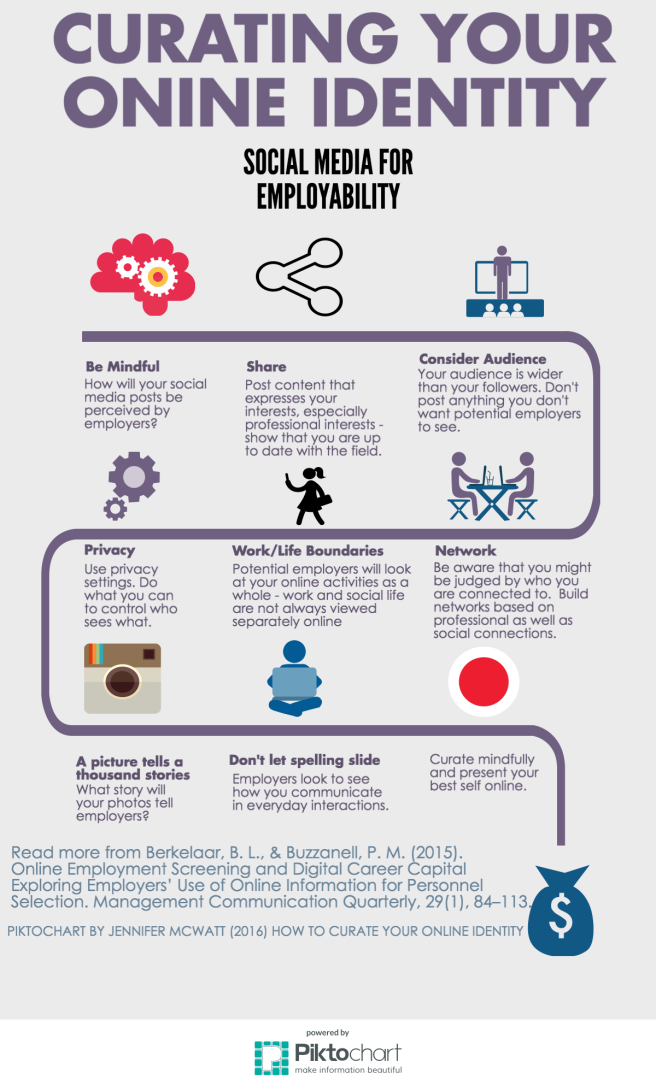Digital Literacies: Blog Post 3
In the last blog post I looked at raising digital presence for employability through building online networks. This week I explore how digital presence can be built through curation and the impact it can have on employability. In my search for literature this week, I have discovered that the word ‘curating’ is used to refer to various digital practices. Within this post I will explore the concept of curating online identities for the purpose of employability.
Cybervetting
Brenda Berkelaar and Patrice Buzzanell (2015) have researched how employers have been evaluating online information about potential candidates during the selection and hiring process. They call this practice ‘cybervetting’ and it is being used to find informal information available online about candidates which they may not have intended for the employers to use in making their judgment call. This could be considered as unethical but there is no law against it that I know of so the best we can do for now is be aware that it is happening and work out how to deal with it.
Employers are looking for both the “presence and absence of different types of online information to make sense of job candidates” (pg. 86). Because of this, candidates need to be aware that it is not just their CV, references, or interview that is being used in the employer’s ‘sensemaking’ process (pg. 107); their social media accounts may be used too. Berkelaar and Buzzanell (pg. 86) consider that “cybervetting increases demand on individuals to curate their digital professional image.” The issue is that individuals may not know how to meet this demand.
Based on ideas from the text, I have created the following infographic with tips on how jobseekers can curate their digital identity and build their “digital career capital” (pg. 106) in preparation for possible cybervetting.

Unintended Audience
Benson, Morgan, and Filippaios (2014, pg 521) drew attention to the fact that employers have the expectation that graduates are aware of how to use social media well. However, it is not the case that graduates really are aware, especially when “employers use social media to check behavior patterns of graduates.” I think employers assume students would not post content that might damage their chances of work, but it is a strong possibility that students are posting for their intended audience – their friends and family – and not for potential employers to view. Realising this is a digital literacy.
Building an awareness of the practice of cybervetting, might help students to be more mindful of how they represent themselves by curating their digital presence as a well-rounded professional person who is ready for employment but this requires education.
Inequality and Missed Opportunities
Deursen and Dijk (2014) wrote about an issue that seems to have more relevance with every area of digital literacy I explore. They found that people of low-level education don’t use the Internet for capital-enhancing activities (pg. 511) such as exploring career opportunities so I could presume that they are not using it to consciously build a professional online identity. Unfortunately, as the knowledge gap widens and reflects offline inequalities, people of lower educational levels continue to miss out on employment opportunities that could enable social mobility.
The Need for Feedback
I realise that many institutions have a careers centre or advisor that do CV checks and practice interviews but I think more is needed. I think it is a step in the right direction that I have seen workshops advertised on things such as building a LinkedIn profile. However, I think an additional service is needed which offers students the chance to be cybervetted and receive feedback. It is easy enough to Google yourself but you don’t know how you might be perceived when your information, images, and networks are reconstructed and decontextualised by others.
I think feedback is incredibly important even if it embarrasses you. When I was 20 I had an interview with a rather mean HR executive but he taught me a lesson. The interview had been going fairly well but then he asked me “What does your email mean?” I hadn’t thought about the fact that the email address I had sent my CV from was one that I had created when I was 15 and it was made up my favourite colour, rock band, and the year I was born. As I sat in my new suit trying to be at my most professional, I hadn’t realised it would be my email address that embarrassed me. Feel free to cringe. He suggested I get a more ‘grown up’ email address.
It was harsh but useful feedback. I think (I hope!) that most young people are savvy enough to having an email address that is their actual name or something sensible but I’m sure they are facing many more digital issues than what their email is. This is why it is so important to promote digital literacies related to online identities and the very real connection to employability. Having an online presence makes people more open to exposure and digital literacy skills such as being aware of curating online identities needs to be taught or opportunities will be lost.
References
Benson, V., Morgan, S., & Filippaios, F. (2014). Social career management: Social media and employability skills gap. Computers in Human Behavior, 30, 519–525. http://doi.org/10.1016/j.chb.2013.06.015
Berkelaar, B. L., & Buzzanell, P. M. (2015). Online Employment Screening and Digital Career Capital Exploring Employers’ Use of Online Information for Personnel Selection. Management Communication Quarterly, 29(1), 84–113. http://doi.org/10.1177/0893318914554657
Deursen, A. J. van, & Dijk, J. A. van. (2014). The digital divide shifts to differences in usage. New Media & Society, 16(3), 507–526. http://doi.org/10.1177/1461444813487959

